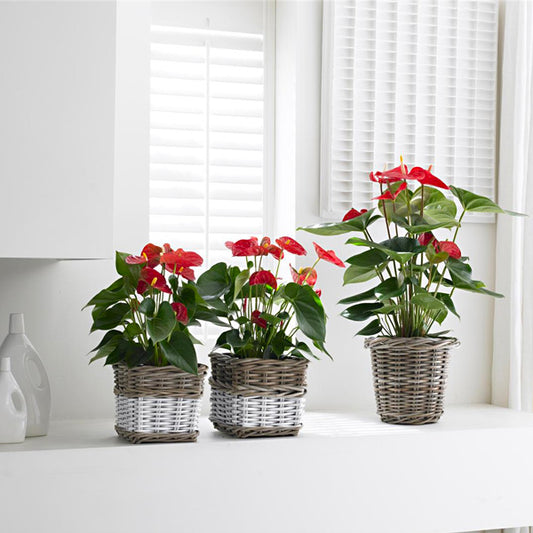Hard cane dendrobiums are hybrids of the Dendrobium species of Sections Phalaenanthe and Ceratobium and involve in their parentage, species that are found growing in the hot, equatorial and tropical forests of Asia. These hybrids are the easiest orchids to grow for a beginner and bloom profusely without much care. For this reason, they are very popular in the tropics. Of late, small teacup varieties have been bred with blooms on plants as small as 2 inches. They commonly come in pink, white, brown, purple, yellow, green and maroon shades.
Light: Dendrobiums can tolerate a lot of light provided they are introduced to it gradually. In the tropics where strong light is associated with heat, plants that are kept in the open can suffer burns when the sun comes out after the monsoons. Ideally, dendrobiums do well under nets allowing 60-70% sunlight to pass through. Plants receiving lesser amounts of light have leaves that are dark green and flowering will be markedly reduced. Ensure that your plants are protected from the afternoon sun especially during the summer. For those who do not have greenhouses, east or west facing balcony which receives a few hours of sunlight would be ideal.
Water: Dendrobiums are sympodial orchids with pseudobulbs that can store food and water. Water when if you notice the media and roots on the surface to be dry. In warmer regions this could be once a day and in colder regions twice a week. More dendrobiums are killed due to overwatering than under-watering. A dendrobium cane(pseudobulb) that looks shriveled indicates it is not getting enough water. Such plants should be watered more often.
Humidity: Hard-cane dendrobiums are not very particular of humidity though they will grow best where humidity levels are between 50-80% throughout the year. Where humidity levels are quite high, no additional setup is necessary. If your region has low humidity, place a tray/plate with water under the pot.
Temperature: Being tropical in nature, they best enjoy temperatures between 20 C -30 C. Unlike the soft cane dendrobiums that require a distinctly cool and dry season to bloom, these will bloom happily throughout the year irrespective of a temperature differential between day and night. They can be grown over most of India but might need to be protected from the cold winds in the North & North-East during winter. In the North, North-East, watering should also be markedly reduced during this period as the plants enter dormancy.
Media and Fertilizer: As mentioned earlier, dendrobiums, being very forgiving can be grown in a wide variety of media. Coconut husk is used extensively as it is cheaper and dendrobiums do well in husk. When selecting pots, choose a pot that has a residual space of 2 inches from the base of the plant to the rim of the pot. Dendrobiums are known to bloom faster once they become pot bound. Repot once the pseudobulbs begin to grow out of the pots or once every 2 to 3 years. They should be preferably grown on stands or hanging to prevent soil-borne infections. Stands also ensures optimal light levels reach the plant and also increases air circulation around the plant. They can be fertilized once a week using HighGrow fertilizer, spray the leaves and also the roots until fertilizer water runs out of the pot.

